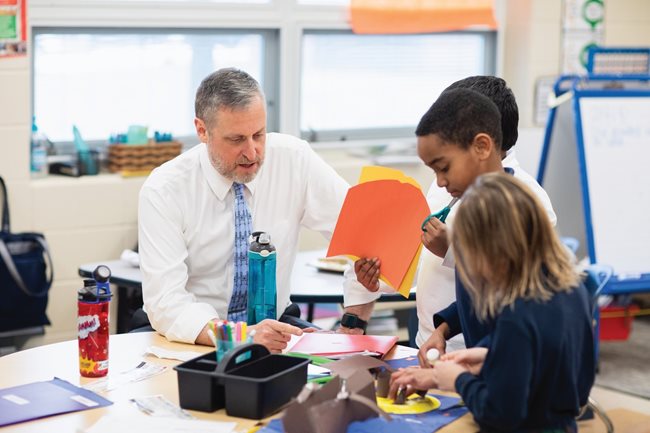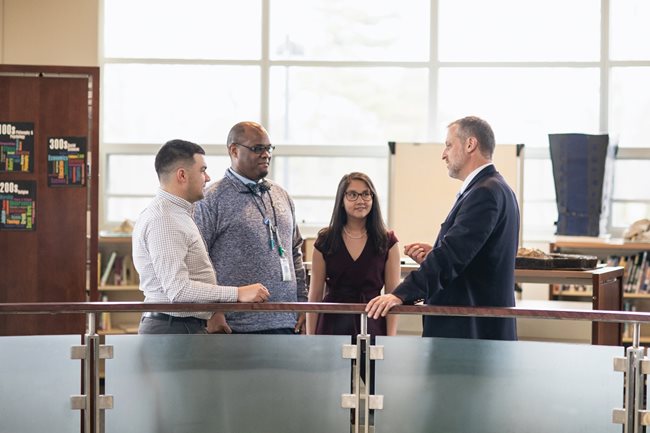 Robert Brisk
Robert Brisk
Head of SchoolThe Wellington School
Columbus, Ohio
Photos by Nick Fancher
This is an excerpt from the NAIS Member Voices podcast.
Tell us about your role. How did you get here?
When I was in college, I got a call from the Dwight-Englewood School (NJ), where I had been a student, asking me if I’d want to come back and teach. I said “no.” And they said, “Would you come talk to us?” so I said “sure.” They offered me a job. I thought I’d do it for a year or two and then do something else. Then I fell in love with it, and one thing led to another. I’ve been head of school at The Wellington School (OH) for 12 years. Prior to that, I was at the Oregon Episcopal School (OR) for eight years and at Dwight-Englewood for 19 years in a variety of roles at each.I found that as head of school I could carve out pockets of time to work on the things that I really wanted to work on. That was different than any of my previous roles, either as a division head, an assistant principal, or a full-time teacher. The ability to do that has been really exciting, giving me the chance to spend dedicated time creating a vision for our engagement work in particular and then helping others to try to achieve that vision.
How are you deepening student engagement at your school?
We’ve been interested in this issue of student engagement, and it’s become something of a buzzword in education. We dedicated time and resources to figuring out a tool that would allow us to measure student engagement for every student, every teacher, and every class on a fairly regular basis. We didn’t want to just talk about student engagement; we wanted to be able to move forward with it. It’s our belief that if we can help students feel that their work is deeply challenging and that they love it, we can make both of those things happen at the same time. That, to us, is student engagement.

Head of School Robert Brisk visits second-graders working on a design-thinking project.
How has your role changed since you started at your school?
This is my last year as head of school. I’m going to be running a separate entity that the board has asked me to run. It will push our engagement work out beyond Wellington in hopes to revolutionize education throughout the world.We started talking about the transition three or four years ago. The work we were doing seemed substantial. We believe that in the same way that student-engagement grants can drive learning, we’re all here to learn. I’m taking this next step, which is in part a little scary but is modeling that same behavior of being willing and ready to move forward.
What’s your state of mind as you take on this new role?
I like that I am nervous and feel challenged because that’s what we want for our students. I’m delighted that I’m feeling a hunger for more in a very different kind of experience. It will be the first time in more than 39 years I haven’t had to wake up and get to school. I have to wake up and do other things, so I’m excited. I’m trying to pair some of the reminiscing with the excitement about getting ready to do another big thing.What lessons have you learned?
I remember fairly late in my career a colleague said, “the thing about running a school is making the trains run on time.” It had never occurred to me that was the object. Now it is certainly true that schools should work. But it seems to me, there’s a far greater mission for us, which is to make our schools exciting places where learning and people are first, systems are second, and then the hope that we can transform education beyond independent schools is one of the exciting joys and challenges. I see that much more clearly than I did at the beginning of my career.What piece of advice do you carry with you?
Becky Blackwell, my first boss, who also was my Latin teacher, taught me to actively listen in a way that doesn’t happen often in my experience. It has been an incredibly useful tool for my whole life. So, listen carefully.What are you reading right now?
I’m always reading three books at a time, so right now I’m reading They’re There, a novel by Tommy Orange; she was a Cheyenne and Arapaho author. I’m reading The Storm Before the Storm, which is about the fall of the Roman Republic. And I’m rereading Crime and Punishment, which was assigned when I was in high school, but I’m pretty sure I never got close to finishing it. So I think I’m reading the first half again, and the second half for the first time.What’s the first thing you do when you arrive on campus?
I have an egg every morning, but other than that, it always varies. One of my jobs is to make sure that every day is not the same, that we will jump, we will investigate, we will think. We have a saying here that if it’s not unsafe, we will support any pilot anybody wants to move forward on. It’s always exciting to come to work, to find out what’s there.What keeps you up at night?
The safety of children is always the first thing that’s on my mind. It is interesting to me that there are topics that we weren’t trained for that have become so significant and so important. Are we doing what ensures our kids are going to be in their best possible zone for learning throughout the day?

Faculty members (from left) Drew Eberly, John Brown, and Victoria Pang discuss student-engagement work with Head of School Robert Brisk.
Where do you turn to for inspiration in your work?
I’ve had many really terrific mentors, and through the Ohio Association of Independent Schools and NAIS, I’ve really gotten to know a variety of heads who are very helpful. I also think that it’s really important to talk to people outside of schools, particularly as we’re trying to bridge some of the paradigms of traditional schooling. Schools can often get so inwardly focused on traditional education that I spend a lot of time talking outside of school about how they manage their issues. Our school happens to be a place of really extraordinary entrepreneurship, so we have a number of folks on our board who have started interesting businesses. The largest single employer of our parents is Ohio State University, so there’s an expert on pretty much everything.What’s one thing about you that few people know?
My father ran a construction company, and one of the happiest days of his life was when I told him I wasn’t going into the business.What’s your proudest moment?
When I see students graduate who have had experiences that have called on their strengths, that’s probably what makes me proudest. Each student has a story of their own, and for many of them, they have taken paths their parents or teachers didn’t expect. When I greet them on the stage as they get their diplomas, I think about how we’ve created a school in which students can dictate, create, and make their own direction and have a hunger to do that elsewhere.If you had one more hour in your day, what would you do?
I’d eat another egg. No, no. I’d sit with my wife or boys, without any electronics, and chat.Listen to the full interview with Robert Brisk on the NAIS Member Voices podcast. Download it now at iTunes, SoundCloud, TuneIn, Stitcher, or GooglePlay. Rate, review, and subscribe to hear a new episode each month.
If you or someone you know would like to be part of Member Voices, drop us a line at [email protected].